신생아의 가슴과 유방, 가외 젖꼭지(부유두/과잉유두), Chests and breasts of newborn infants and Accessory nipple/Supernumerary nipple
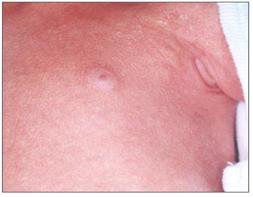
사진2-169.신생아의 정상 유방.
Copyright ⓒ 2012 John Sangwon Lee, MD., FAAP
- 갓 태어난 신생아의 가슴둘레의 크기는 머리통의 둘레의 크기보다 조금 더 작은 것이 정상적이다.
- 가슴통은 둥그스름하게 생긴 것이 보통이다.
- 태어나기 전 자궁 속에 있을 때 태아는 엄마의 난소와 태반으로부터 에스트로젠(에스트로겐) 등 여성 호르몬을 정상적으로 공급받는다.
- 태어난 후 일부의 남녀 신생아들의 유방이 태아기 중 모체나 태반으로부터 받았던 에스트로겐 등 여성 호르몬의 영향으로 생후 1∼2개월 동안 정상적으로 상당히 커져 있을 수 있다.
- 어떤 신생아들의 커진 유방에서 맑은 젖이 몇 방울 흘러나올 수 있다.
- 젖이 흘러나온다고 해서 젖을 함부로 짜거나 신생아의 유방을 불결한 손으로 함부로 만져서도 안 된다.
- 더군다나 불결한 손으로 신생아 젖을 짜거나 유방을 만지면 유방에 세균이 감염되어 신생아 유방 농양이 생길 수 있다.
- 신생 여아에게 함몰 젖꼭지가 있는 것 같다고 해서 신생 여아의 젖꼭지를 잡아 빼 준다고 손으로 유방을 만져서도 절대로 안 된다.
- 신생아에게 함몰 젖꼭지가 있는지 모르는 상태에서 신생아의 젖꼭지를 엄마가 만진다는 것은 절대로 안 됩니다.
- 아주 드물게 정상적으로 난 젖꼭지 이외 가외로 난 젖꼭지가 정상 젖꼭지가 있는 데서 얼마 떨어져 있지 않은 부위에 날 수 있다.
- 이런 가외로 난 젖꼭지를 부 젖꼭지(Accesory nipple), 과잉유두(Supernumerary nipple) 또는 과다 유두라고 한다.
- 참고로 성인 여성의 부 젖꼭지에 유방암이 난 실례도 있다.
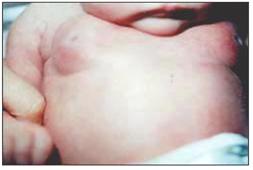
사진 2-170.2주된 신생아의 양쪽 유방이 정상적으로 커져 있다.
생리적 여성형 유방증이라고 한다.
Copyright ⓒ 2012 John Sangwon Lee, MD., FAAP
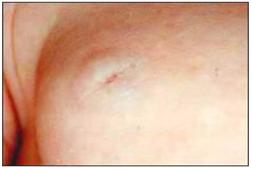
사진 2-171.3주된 신생아의 유방이 정상적으로 커져 있다. 즉, 생리적 여성형 유방증이 생겨 있다. Copyright ⓒ 2012 John Sangwon Lee, MD., FAAP
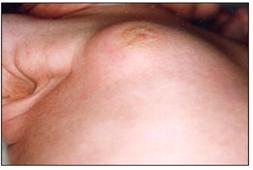
사진 2-172.3주된 신생아의 유방이 정상적으로 커져 있다. 생리적 여성형 유방증이 신생아에게 생겨 있다. Copyright ⓒ 2012 John Sangwon Lee. MD., FAAP
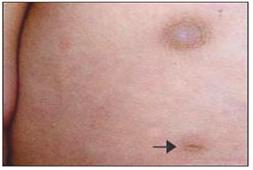
사진 2-173.부 유두(과잉유두‧부 젖꼭지‧가외 젖꼭지/Accessory nipple/Supernumerary nipple)(오른쪽 가슴에 난 가외 젖꼭지) 화살로 표시된 부위에 가외 젖꼭지가 있다.
Copyright ⓒ 2012 John Sangwon Lee, MD., FAAP
표 2-9. 미 남 소아들의 평균 흉위와 양 골반능 간격
|
평균흉위 양 골반능 간격 나 이 |
흉위 (인치) | 흉위 (Cm) | 양 골반능 간격(인치) | 양 골반능 간격 (cm) |
| 출생 시 | 13.7 | 35 | 3.2 | 8 |
| 생후 3개월 | 16.2 | 40 | 4.3 | 11 |
| 생후 6개월 | 17.3 | 44 | 4.8 | 11 |
| 생후 1년 | 18.3 | 47 | 5.1 | 13 |
| 생후 18개월 | 18.9 | 48 | 5.5 | 14 |
| 생후 2세 | 19.5 | 50 | 6.0 | 15 |
| 3세 | 30.4 | 52 | 6.2 | 16 |
| 4세 | 21.2 | 53 | – | – |
| 5세 | 22.0 | 55 | 7.2 | 18 |
| 6세 | 22.5 | 56 | – | – |
| 7세 | 23.0 | 57 | 8.2 | 20 |
| 8세 | 24.0 | 58 | – | – |
| 9세 | 24.5 | 60 | 8.5 | 21 |
| 10세 | 25.1 | 61 | – | – |
| 12세 | 27.5 | 66 | 9.5 | 22 |
| 14세 | 29.0 | 72 | 11.0 | 28 |
| 16세 | 31.0 | 77 | – | – |
| 18세 | 33.0 | 82 | 12.2 | 31 |
| 20세 | 34.5 | 86 | 12.6 | 32 |
Chests and breasts of newborn infants and Accessory nipple/Supernumerary nipple

Picture 2-169. Normal breast of a newborn. Copyright ⓒ 2012 John Sangwon Lee, MD., FAAP
• It is normal for the size of the chest circumference of a newborn baby to be slightly smaller than the size of the circumference of the head.
• Chest is usually round.
• When in the womb before birth, the fetus receives the normal supply of female hormones such as estrogen from the mother’s ovaries and placenta.
• After birth, the breasts of some male and female newborns may become significantly enlarged normally during the first to two months of life due to the influence of female hormones such as estrogen received from the mother or placenta during the prenatal period.
• A few drops of clear breast milk may flow from the enlarged breasts of some newborns.
• Do not express milk or touch a newborn’s breast with unclean hands just because it is leaking.
• What’s more, if you express your newborn baby’s milk or touch the breast with unclean hands, bacteria can infect the breast, resulting in a newborn breast abscess.
• Never touch the breasts with your hands to pull the newborn girl’s nipples out just because they appear to have inverted nipples.
• A mother should never touch a newborn’s nipple without knowing if the newborn has an inverted nipple.
• In very rare cases, an extra-nipple other than a normal nipple may appear not far from the normal nipple.
• These extra nipples are called accessory nipples, supernumerary nipples, or excess nipples.
• For reference, there is a case of an adult woman having breast cancer in the secondary nipple.

Picture 2-170. 2 weeks old newborn both breasts are normally enlarged. This is called physiological gynecomastia. Copyright ⓒ 2012 John Sangwon Lee, MD., FAAP

Picture 2-171. 3-week-old newborn’s breast is enlarged normally. That is, physiological gynecomastia has occurred. Copyright ⓒ 2012 John Sangwon Lee, MD., FAAP

Picture 2-172. 3-week-old newborn’s breast is enlarged normally. Physiological gynecomastia occurs in newborns. Copyright ⓒ 2012 John Sangwon Lee. MD., FAAP

Picture 2-173. Secondary nipple (excess nipple, accessory nipple, extra nipple/Accessory nipple/Supernumerary nipple) (extra nipple on the right breast). There is an extra nipple in the area indicated by the arrow. Copyright ⓒ 2012 John Sangwon Lee, MD., FAAP
Table 2-9. Mean chest size and bilateral pelvic crest spacing in male children average chest pelvic floor gap, 표 2-9. 미 남 소아들의 평균 흉위와 양 골반능 간격
|
average chest pelvic floor gap age |
chest (inches) | Chest (Cm) | Both pelvic crest spacing (inches) | Both pelvic crest spacing (inches) |
| at birth | 13.7 | 35 | 3.2 | 8 |
| 3 months old | 16.2 | 40 | 4.3 | 11 |
| 6 months old | 17.3 | 44 | 4.8 | 11 |
| 12 months old | 18.3 | 47 | 5.1 | 13 |
| 18 months old | 18.9 | 48 | 5.5 | 14 |
| 2 years old | 19.5 | 50 | 6.0 | 15 |
| 3 years old | 30.4 | 52 | 6.2 | 16 |
| 4 years old | 21.2 | 53 | – | – |
| 5 years old | 22.0 | 55 | 7.2 | 18 |
| 6 years old | 22.5 | 56 | – | – |
| 7 years old | 23.0 | 57 | 8.2 | 20 |
| 8 years old | 24.0 | 58 | – | – |
| 9 years old | 24.5 | 60 | 8.5 | 21 |
| 10 years old | 25.1 | 61 | – | – |
| 12 years old | 27.5 | 66 | 9.5 | 22 |
| 14 years old | 29.0 | 72 | 11.0 | 28 |
| 16 years old | 31.0 | 77 | – | – |
| 18 years old | 33.0 | 82 | 12.2 | 31 |
| 20 years old | 34.5 | 86 | 12.6 | 32 |
출처 및 참조 문헌;
- Nelson Textbook of Pediatrics 22ND Ed
- The Harriet Lane Handbook 22ND Ed
- Growth and development of the children
- www.drleepediatrics.com 제1권 소아청소년 응급 의료
- www.drleepediatrics.com 제2권 소아청소년 예방
- www.drleepediatrics.com 제3권 소아청소년 성장 발육 육아
- www.drleepediatrics.com 제4권 모유,모유수유, 이유
- www.drleepediatrics.com 제5권 인공영양, 우유, 이유식, 비타민, 미네랄, 단백질, 탄수화물, 지방
- www.drleepediatrics.com 제6권 신생아 성장 발육 육아 질병
- www.drleepediatrics.com제7권 소아청소년 감염병
- www.drleepediatrics.com제8권 소아청소년 호흡기 질환
- www.drleepediatrics.com제9권 소아청소년 소화기 질환
- www.drleepediatrics.com제10권. 소아청소년 신장 비뇨 생식기 질환
- www.drleepediatrics.com제11권. 소아청소년 심장 혈관계 질환
- www.drleepediatrics.com제12권. 소아청소년 신경 정신 질환, 행동 수면 문제
- www.drleepediatrics.com제13권. 소아청소년 혈액, 림프, 종양 질환
- www.drleepediatrics.com제14권. 소아청소년 내분비, 유전, 염색체, 대사, 희귀병
- www.drleepediatrics.com제15권. 소아청소년 알레르기, 자가 면역질환
- www.drleepediatrics.com제16권. 소아청소년 정형외과 질환
- www.drleepediatrics.com제17권. 소아청소년 피부 질환
- www.drleepediatrics.com제18권. 소아청소년 이비인후(귀 코 인두 후두) 질환
- www.drleepediatrics.com제19권. 소아청소년 안과 (눈)질환
- www.drleepediatrics.com 제20권 소아청소년 이 (치아)질환
- www.drleepediatrics.com 제21권 소아청소년 가정 학교 간호
- www.drleepediatrics.com 제22권 아들 딸 이렇게 사랑해 키우세요
- www.drleepediatrics.com 제23권 사춘기 아이들의 성장 발육 질병
- www.drleepediatrics.com 제24권 소아청소년 성교육
- www.drleepediatrics.com 제25권 임신, 분만, 출산, 신생아 돌보기
- Red book 29th-31st edition 2021
- Nelson Text Book of Pediatrics 19th- 21st Edition
- The Johns Hopkins Hospital, The Harriet Lane Handbook, 22nd edition
- 응급환자관리 정담미디어
-
소아가정간호백과–부모도 반의사가 되어야 한다, 이상원
-
Neonatal Resuscitation American heart Association
-
Neonatology Jeffrey J.Pomerance, C. Joan Richardson
-
Pediatric Resuscitation Pediatric Clinics of North America, Stephen M. Schexnayder, M.D.
-
Pediatric Critical Care, Pediatric Clinics of North America, James P. Orlowski, M.D.
-
Preparation for Birth. Beverly Savage and Dianna Smith
-
Infectious disease of children, Saul Krugman, Samuel L Katz, Ann A. Gershon, Catherine Wilfert
- 소아과학 대한교과서
- Other
|
Copyright ⓒ 2015 John Sangwon Lee, MD., FAAP 미국 소아과 전문의, 한국 소아청소년과 전문의 이상원 저“부모도 반의사가 되어야 한다”-내용은 여러분들의 의사로부터 얻은 정보와 진료를 대신할 수 없습니다. “The information contained in this publication should not be used as a substitute for the medical care and advice of your doctor. There may be variations in treatment that your doctor may recommend based on individual facts and circumstances. “Parental education is the best medicine.” |